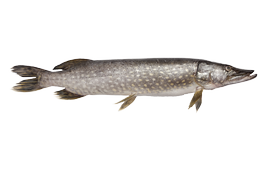
PIKE
Can hardly be mistaken for any other fish. The body is torpedo-shaped and built for hunting. Its big mouth is full of sharp teeth. The yellow-green color varies depending on the age of the fish and the water.
Fish facts
A pike can weigh up to 34 kg. Old pike become inedible and also amass toxins because they are at the top of the food chain.
How to cook pike
Pike’s reputation as a bony fish is exaggerated, but the flesh is lean and easily damaged and it is hard to fillet. It’s best to mince it and add fat in the form of butter and cream. Pike is at its best in autumn, winter and spring.
The good binding ability of the flesh is the reason why the French, in particular often use pike in quenelles and pâtés. The flesh is also often an attractive pink color. Added fat and other ingredients in quenelles and fish balls make them moist, but you need to be careful about the temperature when you’re cooking them. Aim for about 50°C. Serve with a fine white wine sauce.
Pike is also good to cook whole, e.g. on a bed of salt in the oven, with its own skin as a “shell” holding it all together. The best-tasting pike weigh between 1 and 1.5 kg. The flesh of bigger pike can be dry.
The classic
Camp-fire pike (wrapped in several layers of butter paper and newspaper and cooked in the coals and ashes under an open fire).
Conservation status:
Green.








